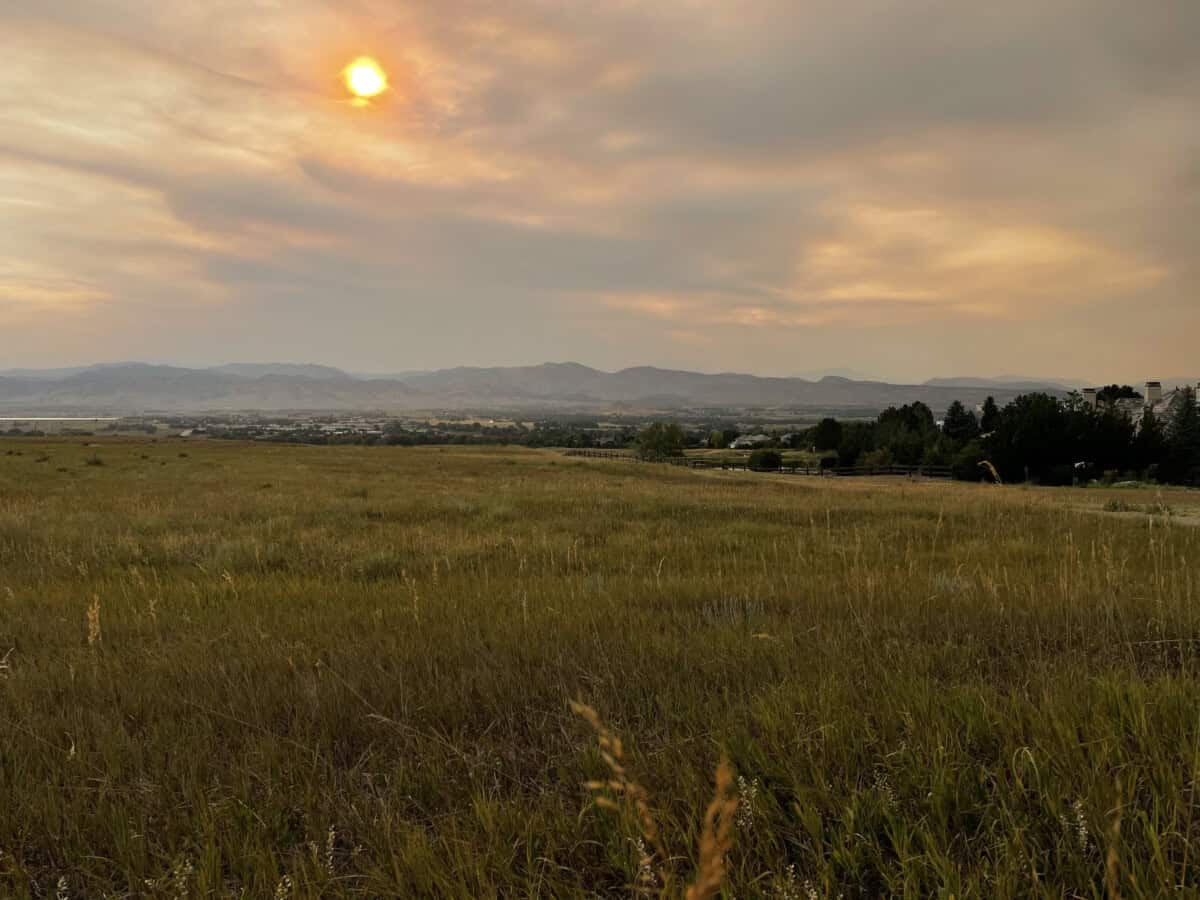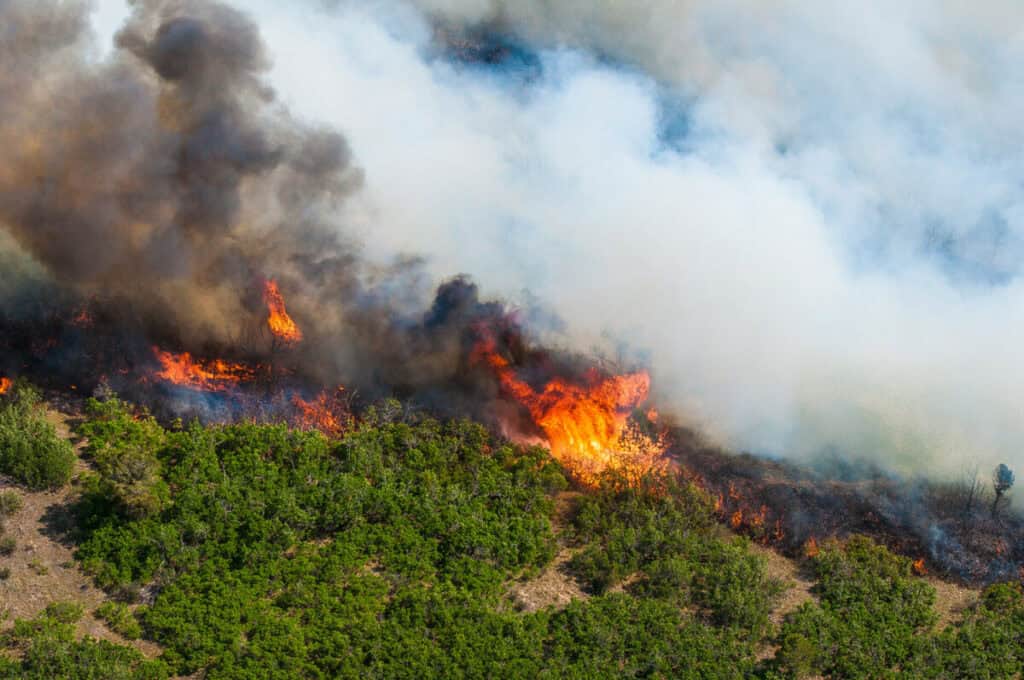What Are the Health Effects of Wildfire Smoke?

Colorado’s wildfire seasons are getting longer, hotter, and more unpredictable. Residents across the Front Range are seeing wildfire smoke in the skies more often each year. That haze isn’t just a nuisance, it comes with serious health effects of wildfire smoke that everyone should understand.
Whether you’re camping, spending time outdoors when the Air Quality Index (AQI) is high and air quality is unhealthy, or just trying to keep your home safe during peak fire season, it’s important to understand how wildfire smoke affects your body and how to minimize your exposure.
What’s in Wildfire Smoke?
Wildfire smoke is a mix of gases and fine particles released when vegetation, buildings, and other materials burn. It contains PM2.5, carbon monoxide, volatile organic compounds (VOCs), and other chemical irritants.
Among these, PM2.5, tiny particles smaller than 2.5 microns, is the biggest concern for human health because it can be inhaled deep into the lungs.
Why It’s Dangerous
Once inhaled, PM2.5 and other toxins can enter your bloodstream and trigger inflammation throughout the body. This becomes especially risky during extended exposure in fire-prone areas, like foothill communities and mountain towns across Colorado.
Over time, it can worsen respiratory and cardiovascular conditions, even in healthy individuals.

Short-Term Health Effects of Wildfire Smoke
Respiratory Symptoms
Breathing in wildfire smoke can quickly lead to respiratory irritation, even in healthy individuals. Common symptoms include coughing, wheezing, scratchy throat, and shortness of breath.
People with asthma or other lung conditions may notice more frequent or severe flare-ups. Exposure also raises the risk of bronchitis, worsens pollen allergy symptoms, and can make it harder to recover from existing respiratory illnesses.
Cardiovascular Symptoms
The effects aren’t limited to your lungs. Smoke exposure may cause chest pain, a rapid heartbeat, and increased risk of stroke or heart attack, especially in those with existing heart conditions.
Even short bursts of exposure during high-smoke days in places like Longmont can impact your cardiovascular system.
Other Immediate Issues
Additional symptoms include stinging eyes, runny nose, fatigue, headaches, and irritated sinuses. These often appear within hours of exposure.
Long-Term Effects of Smoke Inhalation
Lung Function Decline
Prolonged or repeated exposure to wildfire smoke may lead to reduced lung function and chronic inflammation in the airways. This is especially true for firefighters, outdoor workers, and people living in high-smoke regions of Colorado.
Over time, symptoms like persistent coughing and wheezing may become more frequent or severe, even outside of wildfire season.
Unknown Risks
While long-term research is still developing, exposure to wildfire smoke has been linked to chronic respiratory illnesses, including long-term conditions like asthma and Chronic Obstructive Pulmonary Disease (COPD). There’s also growing concern about potential impacts on cardiovascular health, especially with repeat exposure over multiple years.
From the mental health side, heavy smoke days can trigger anxiety, irritability, and stress, particularly for people already dealing with asthma.

High-Risk Populations in Colorado
Certain groups are more likely to suffer from the health effects of wildfire smoke. This includes children, seniors, pregnant individuals, and people with asthma, COPD, or heart disease.
Occupational Risk
Some jobs come with daily smoke exposure during fire season. Outdoor workers, firefighters, and seasonal employees at summer camping spots and mountain tourist attractions may breathe in smoke for hours each day.
Recognizing Wildfire Smoke Symptoms
Exposure to wildfire smoke can lead to a range of smoke sensitivity symptoms. Look out for persistent coughing, phlegm, irritated eyes, sore throat, and dizziness, especially on high AQI days.
These signs can show up quickly and vary from mild discomfort to more serious respiratory issues depending on your health and exposure level.
When to Seek Help
Don’t ignore symptoms that linger beyond a day or two. If you have trouble breathing, feel lightheaded, or your condition worsens, it’s time to see a doctor. For more severe symptoms like chest pain or severe shortness of breath, call 911 immediately.
How to Keep Wildfire Smoke Out of House
When wildfire smoke hits Colorado, protecting your indoor air quality is key. Start by sealing windows and doors to keep smoke from seeping inside.
Use an air filter for wildfire smoke, ideally one rated HEPA or MERV 13+, to reduce fine particle buildup. Designate a clean room where air is filtered and surfaces are kept free from dust or pollutants. This space can offer temporary relief during high AQI days in areas like Longmont.
HVAC & Filters
If you have central air, run your HVAC system on recirculate mode to avoid pulling in smoky air from outside. Use the highest-rated filter your system supports. Avoid using swamp coolers or other systems that bring in unfiltered outdoor air.
Extra Protection
Portable air cleaners with HEPA filters can help clean smaller rooms. If your home becomes too hot or smoky, relocate temporarily to a filtered public space like a community center or shopping mall.
Fire Smoke Allergy Treatment
Over-the-Counter Options
For mild smoke sensitivity symptoms, common over-the-counter treatments can offer relief.
Antihistamines, nasal sprays, and lubricating eye drops help reduce irritation caused by wildfire smoke, similar to how they treat pollen allergy symptoms. These are especially helpful during high-smoke days in Colorado’s fire season.
Medical Treatments
If symptoms persist or worsen, medical treatment may be necessary. Doctors may prescribe inhalers, corticosteroids, or other medications for people with asthma or COPD. If you’re experiencing repeated flare-ups, talk with your provider about a long-term plan. Early treatment can prevent smoke-related complications from getting worse.
Resources for Colorado Residents
State and Local Alerts
Stay informed by signing up for CDPHE air quality alerts and checking the latest updates on the AirNow fire and smoke map.
Residents should also stay informed through local emergency notifications about wildfire activity, air quality changes, and evacuation notices.
Public Health Recommendations
For evacuation guidance and general wildfire safety, refer to trusted sources like Ready.gov and the CDC. You can also monitor active burn permits and smoke restrictions through the regularly updated Colorado Smoke Blog, which provides statewide and regional information.
FAQs
What are the health effects of wildfire smoke?
Exposure to wildfire smoke can lead to coughing, asthma flare-ups, chest pain, and fatigue. It can also trigger irritated sinuses, sore throat, and headaches.
What are the long term effects of smoke inhalation?
Ongoing or seasonal exposure may result in reduced lung capacity, chronic bronchitis, and increased cardiovascular risk.
How can I treat fire smoke allergy symptoms?
Mild symptoms can be treated with antihistamines, nasal sprays, and eye drops. People with asthma or COPD may need prescription inhalers or corticosteroids.
What’s the best air filter for wildfire smoke?
Use a HEPA filter or a MERV 13+ rated system. These can effectively remove PM2.5 particles and other harmful pollutants from indoor air.
How can I keep wildfire smoke out of the house?
Seal doors and windows. Run your HVAC system on recirculate, and create a clean room using a portable air cleaner with a HEPA filter.






